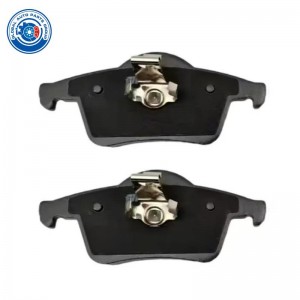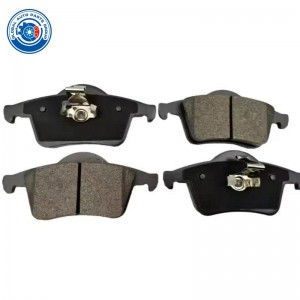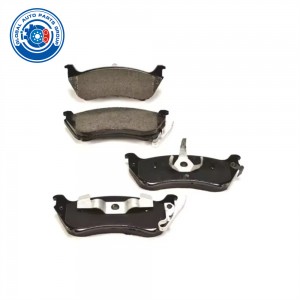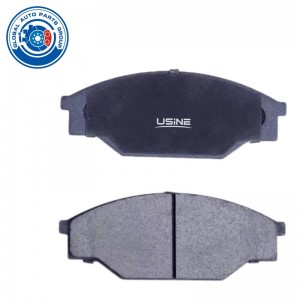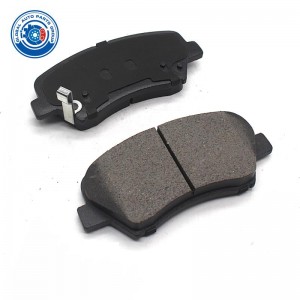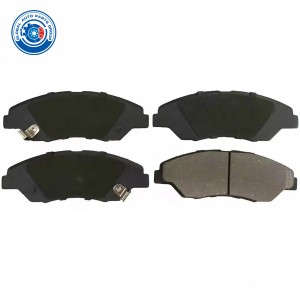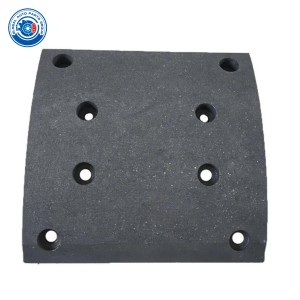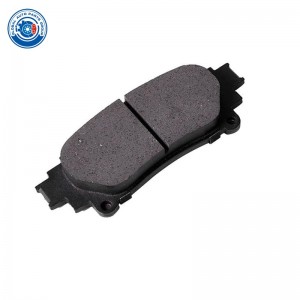D795 High quality semi-metal brake pads
Method 1: Look at the thickness
The thickness of a new brake pad is generally about 1.5cm, and the thickness will gradually become thinner with continuous friction in use. Professional technicians suggest that when the naked eye observation brake pad thickness has only left the original 1/3 thickness (about 0.5cm), the owner should increase the frequency of self-test, ready to replace. Of course, individual models due to wheel design reasons, do not have the conditions to see the naked eye, need to remove the tire to complete.
Method 2: Listen to the sound
If the brake is accompanied by the sound of "iron rubbing iron" at the same time (it may also be the role of the brake pad at the beginning of the installation), the brake pad must be replaced immediately. Because the limit mark on both sides of the brake pad has directly rubbed the brake disc, it proves that the brake pad has exceeded the limit. In this case, in the replacement of brake pads at the same time with the brake disc inspection, this sound often occurs when the brake disc has been damaged, even if the replacement of new brake pads still can not eliminate the sound, serious need to replace the brake disc.
Method 3: Feel Strength
If the brake feels very difficult, it may be that the brake pad has basically lost friction, and it must be replaced at this time, otherwise it will cause a serious accident.
Brake pads can wear out too quickly for a variety of reasons. Here are some common causes that can cause rapid wear of brake pads:
Driving habits: Intense driving habits, such as frequent sudden braking, long-term high-speed driving, etc., will lead to increased brake pad wear. Unreasonable driving habits will increase the friction between the brake pad and the brake disc, accelerating wear
Road conditions: driving in poor road conditions, such as mountainous areas, sandy roads, etc., will increase the wear of brake pads. This is because brake pads need to be used more frequently in these conditions to keep the vehicle safe.
Brake system failure: The failure of the brake system, such as the uneven brake disc, brake caliper failure, brake fluid leakage, etc., may lead to abnormal contact between the brake pad and the brake disc, accelerating the wear of the brake pad.
Low quality brake pads: The use of low quality brake pads may lead to the material is not wear-resistant or the braking effect is not good, thus accelerating wear.
Improper installation of brake pads: incorrect installation of brake pads, such as incorrect application of anti-noise glue on the back of brake pads, incorrect installation of anti-noise pads of brake pads, etc., may lead to abnormal contact between brake pads and brake discs, accelerating wear.
If the problem of brake pads wearing too fast still exists, drive to the repair shop for maintenance to determine if there are other problems and take appropriate measures to solve them.
1, this is often caused by brake pads or brake disc deformation. It is related to material, processing accuracy and heat deformation, including: thickness difference of brake disc, roundness of brake drum, uneven wear, heat deformation, heat spots and so on.
Treatment: Check and replace the brake disc.
2. The vibration frequency generated by the brake pads during braking resonates with the suspension system. Treatment: Do brake system maintenance.
3. The friction coefficient of brake pads is unstable and high.
Treatment: Stop, self-check whether the brake pad is working normally, whether there is water on the brake disc, etc., the insurance method is to find a repair shop to check, because it may also be the brake caliper is not properly positioned or the brake oil pressure is too low.
Under normal circumstances, the new brake pads need to be run in 200 kilometers to achieve the best braking effect, therefore, it is generally recommended that the vehicle that has just replaced the new brake pads must be driven carefully. Under normal driving conditions, the brake pads should be checked every 5000 kilometers, the content not only includes the thickness, but also check the wear state of the brake pads, such as whether the degree of wear on both sides is the same, whether the return is free, etc., and the abnormal situation must be dealt with immediately. About how the new brake pads fit in.
| Volvo (Regal). S60 sedan 2000/07-2010/04 | S60 sedan 2.5 T | S80 sedan 2.4 T | V70 Generation Station Wagon 2.0 | V70 II station wagon 2.0 T | V70 II station wagon 2.4 T |
| S60 sedan 2.0 T | S60 sedan 2.5 T AWD | S80 sedan 2.4 T5 AWD | V70 Generation Station Wagon 2.0 | V70 II station wagon 2.3 T5 | V70 II station wagon 2.4 T AWD |
| S60 sedan 2.4 | S60 sedan T5 | S80 sedan 2.5 T | V70 generation station wagon 2.3 Turbo | V70 II station wagon 2.4 | V70 II station wagon 2.4 T5 |
| S60 sedan 2.4 | Volvo (Regal). S80 sedan 1998/05-2008/02 | S80 sedan 2.5 T AWD | V70 Generation Station Wagon 2.4 | V70 II station wagon 2.4 | V70 II station wagon 2.5 T |
| S60 sedan 2.4 Bifuel (CNG) | S80 sedan 2.0 | S80 sedan 2.5 TDI | V70 Generation Station Wagon 2.4 | V70 II Wagon 2.4 Bifuel (CNG) | V70 II station wagon 2.5 T AWD |
| S60 sedan 2.4 D | S80 sedan 2.0 T | S80 sedan 2.8 T6 | V70 Generation Station Wagon 2.4 | V70 II station wagon 2.4 D | V70 II station wagon 2.5 TDI |
| S60 sedan 2.4 D | S80 sedan 2.0 T | S80 sedan 2.9 | V70 generation station wagon 2.4 Bifuel | V70 II station wagon 2.4 D | Volvo (Regal). XC70 generation station wagon 1997/10-2007/10 |
| S60 sedan 2.4 D5 | S80 sedan 2.4 | S80 sedan 2.9 | V70 Generation Station Wagon 2.4 Turbo AWD | V70 II station wagon 2.4 D5 | XC70 Generation Tourer 2.4 D5 AWD |
| S60 sedan 2.4 D5 | S80 sedan 2.4 | S80 sedan 3.0 | V70 Generation Station Wagon 2.4 Turbo AWD | V70 II station wagon 2.4 D5 | XC70 Generation Tourer 2.4 D5 XC AWD |
| S60 sedan 2.4 T | S80 sedan 2.4 Bifuel (CNG) | S80 sedan 3.0 T6 | V70 generation station wagon 2.5 TDI | V70 II station wagon 2.4 D5 AWD | XC70 Generation Tourer 2.4 T XC AWD |
| S60 sedan 2.4 T AWD | S80 sedan 2.4 D | Volvo (Regal). V70 generation station wagon 1995/12-2000/12 | Volvo (Regal). V70 II station wagon 1999/11-2008/12 | V70 II station wagon 2.4 D5 AWD | XC70 Generation Tourer 2.5 T XC AWD |
| S60 sedan 2.4 T5 | S80 sedan 2.4 D5 |
| 37098 | FDB1383 | 8223480 | 272944 | 32348 | 7516 |
| 37098 0E | FSL1383 | 120843 | 274334 | 5730215 | 7516S |
| AC669081D | 7665-D795 | 7665D795 | 862 362 | 55 91 6360 | 271400 |
| 607135 | D795 | D7957665 | 2723 997 | 2307602 | 573021S |
| 13.0460-7135.2 | D795-7665 | FBP1146 | 8623862 | 2307691 | 55916360 |
| 13.0470-7135.2 | FBP-1146 | 22-0348-0 | 8634 925 | 2307516505 | 2307617505T4067 |
| 573021B | BL1717A1 | 714 | 3 064 838-2 | 23076 175 0 5 T4067 | 811027004 |
| DB1456 | 6113892 | 025 230 7616 | 8634 9255 | 8110 27004 | 3570 |
| 0 986 424 539 | 181298 | MDB1943 | 10349 | 357 | V950146 |
| PA1251 | 5730211 | CD8366 | T1190 | GDB1389 | 151-1250 |
| P 86 014 | 05P705 | FD6856A | 7.516 | V95-0146 | P6143.00 |
| 822-348-0 | 363702161109 | FD6856N | 7.516S | 597321 | 23075 |
| ADB0729 | 6590 | 224821 | BP1104 | 598480 | 23076 |
| CBP0729 | 370980E | 272 399 | 2714 | 862362 | 23077 |
| LP1504 | 13046071352 | 2203480 | 669081 | 2723997 | 23076.175.1 |
| B110816 | 13047071352 | 71400 | D3286 | 8634925 | 1511250 |
| 12-0843 | 986424539 | 252307616 | 1501224821 | 30648382 | P614300 |
| 16360 | P86014 | 272399 | 764 | 86349255 | 230761751 |




